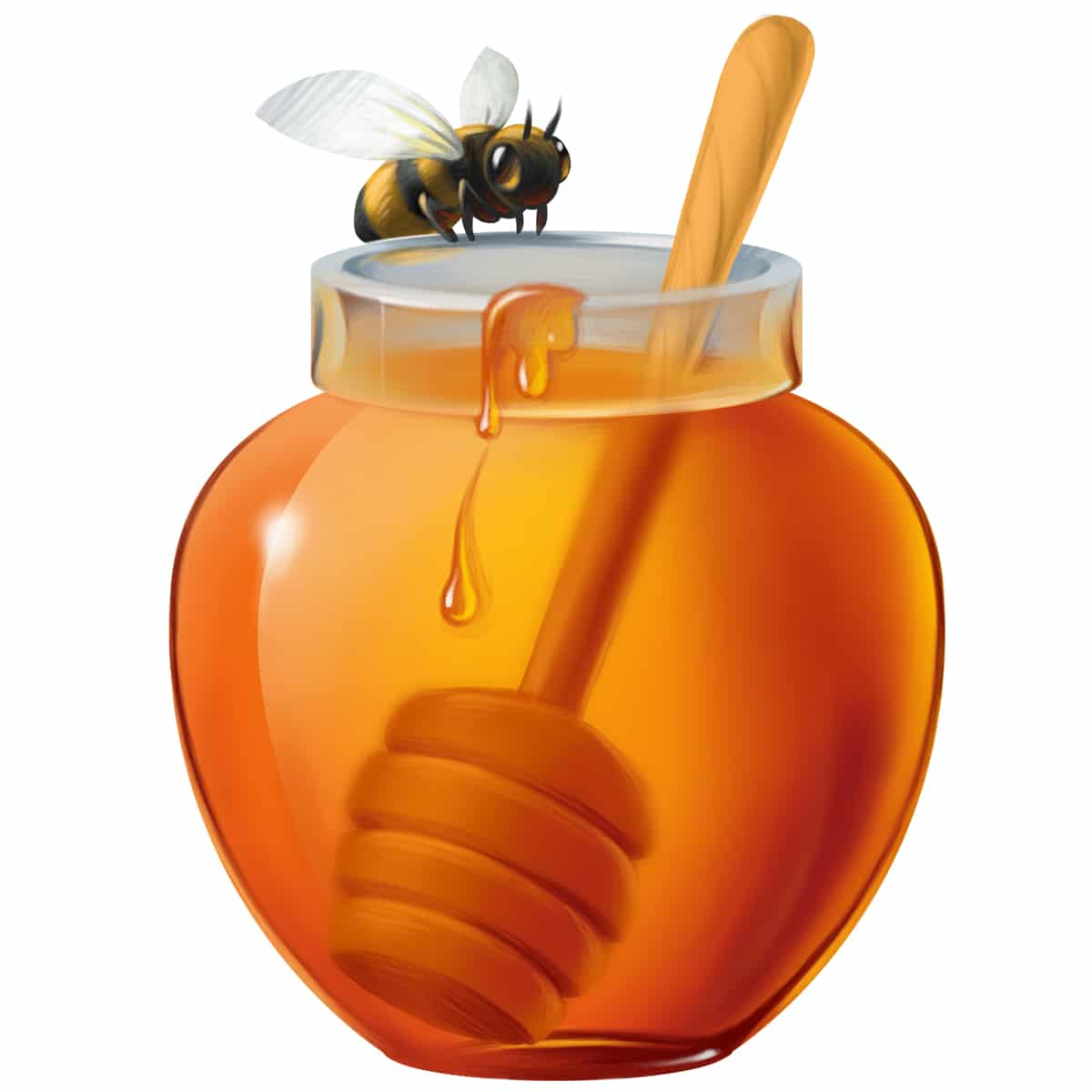On a Paleo diet, sugar is definitely out – even the fancy “Sugar in the Raw” packages that try to tempt you with a more “natural” brown color. But the case of honey isn’t quite so clear-cut. While it’s very sweet, honey is a whole food, and it was probably available in the Paleolithic, albeit not in a cute little squeeze bear. And we also have some evidence of very healthy and lean people in traditional societies who consume honey in fairly large amounts.
So are its natural origins enough to give honey the Paleo seal of approval, or is it really just another kind of “real food candy” that ought to be minimized?
Honey and Fructose
The big point against honey is its fructose content.
A quick review of some key terms (you can skip this paragraph if you already know about the difference between glucose and fructose): once you eat them, all carbohydrates are broken down into their basic building blocks, called simple sugars or monosaccharides. Even though they’re all “carbs,” not all of these simple sugars are equal. Glucose, for example, is your brain’s favorite fuel; it’s easy to store as energy in your muscles for a future workout, and it’s generally good for you. Fructose, on the other hand, is a lot harder to metabolize because it has to be processed in your liver first (just like alcohol). So for a Paleo-friendly carb intake, the ideal is to prefer glucose and avoid fructose where possible.
Honey varies in its ratio of glucose to fructose; an average set of numbers is something like 38% fructose and 30% glucose, with small amounts of other carbohydrates making up the balance. For comparison, pure table sugar is 50% glucose and 50% fructose with nothing else.
Another way of thinking about is to look at the total amount of fructose. 1 tablespoon (21 grams) of honey contains about 8 grams of fructose, although again, it varies depending on your honey. For comparison, that’s approximately equivalent to the amount of fructose that you’ll find in:
- 1 small Granny Smith apple, or
- 2 cups of strawberries, or
- 1 large peach
But while the fruit comes packaged with nutrients and fiber along for the ride, the tablespoon of honey doesn’t really have much to brag about. Look up the nutrition information and you’ll find a row of 0s: no fiber, no vitamins, no minerals, no protein, no fat. So if you want a healthy way to enjoy the sweet taste of fructose, the fruit seems to be a better option.
Health Benefits of Honey?
On the other hand, this study suggests that we can’t just look at the dangers of pure fructose and apply them to honey: compared to an equivalent amount of purified fructose from a lab, fructose in honey was much less harmful. So is there something in honey, as a whole food, that minimizes the impact of the fructose?
Honey-lovers say yes: it’s not the vitamin or mineral content of the honey that matters; it’s all the other good stuff that comes in small but significant amounts. Each batch of honey is unique, but on average honey does contain about 180 component parts that might still have health benefits even if they aren’t technically “vitamins.” So what are the potential health benefits of all these bioactive goodies, and do they have any benefits outside of a test tube or a rat?
Antibiotic Activity and Immune Function
The special chemical compounds in honey are most famous for making it into a powerful all-natural antibiotic: it’s been used on wounds since we could figure out how to get it out of the hive, and it shows some promise for treating antibiotic-resistant germs.
This study (in mice, but still interesting) also suggests that at least some of those benefits may be available to people who eat honey. The researchers gave the mice the human equivalent of 2 tbsp. of honey per day, and then injected them with various antigens including E. coli. The honey group produced significantly more antibodies than the control group.
This doesn’t make honey a cure-all for bacterial infections: improving an already healthy immune response in mice is a far cry from curing a disease in humans. Honey will not substitute for antibiotics when you’re sick! But it does suggest that it might at least help. And this review also suggests that it may help reduce the symptoms of a cough. So on the whole, there’s some evidence that honey may have a small medicinal effect.
Seasonal Allergies
Honey from your own local area may also be able to help with seasonal allergies. This study examined 44 patients who were allergic to birch pollen. The patients got either honey that included birch pollen or honey that didn’t, and sure enough, the birch pollen honey group had reduced allergy symptoms in the spring.
On the other hand, another small study found that local honey had no benefit over honey-flavored sugar water in reducing allergy symptoms. The researchers tested both raw, unfiltered honey and the standard grocery-store variety and found no benefit from either.
It’s possible that honey is helpful for some types of allergies but not others; it’s also possible that it simply doesn’t do anything at all. Until we have some studies with larger sample sizes, the best anyone can really say is that there’s room for optimism.
Prebiotics
From a nutritional perspective, one advantage might be the carbohydrates in honey that aren’t glucose or fructose. About 5-10% of the sugars in honey come from a group called oligosaccharides. Oligosaccharides are just chains of monosaccharides (glucose and/or fructose) stuck together. Their main benefit is their prebiotic activity: they provide food for your gut flora. This study, for example, found that honey compared to pure sucrose (glucose + fructose with no other sugars) increased the number of beneficial lactobacillus bacteria in rats.
There’s always an “other hand,” though, and in this case the other hand is FODMAPs. Those beneficial prebiotics might not be quite so beneficial if you struggle to digest FODMAPs carbohydrates, so consider your individual gut tolerance before you turn to honey as a savior.
Blood Lipid Improvements
In some studies (this one, for example), honey has also been effective in slightly improving blood lipid profiles, by lowering LDL cholesterol, triglycerides, and C-reactive protein (a marker of inflammation), and increasing HDL cholesterol. The effects of honey in this study were tested against “imitation honey” (the right ratio of fructose:glucose but nothing else) and also against pure glucose, and honey clearly came out on top. But some other studies have shown less impressive results or no difference, and the effects, if they exist, are likely to be small.
Antioxidants
Honey also has some antioxidants: this study, for example, found that buckwheat honey increased antioxidant activity in real live humans (namely, not in a test tube or a rat). You can get antioxidants from plenty of other places, but a few more never really hurt.
Blood Sugar Response
Honey is easier on blood sugar than other sweeteners and doesn’t require insulin to metabolize, prompting this study to examine it as a potential antidiabetic. But there’s a catch: the lower glycemic index is a direct result of the higher fructose content, which comes with its own drawbacks. So it’s really a “pick your poison” scenario: would you rather have stress on your liver or stress on your blood sugar? Also, as the study points out, the research into this topic is complicated and incomplete, with many studies done on rats or in test tubes rather than human subjects. So file this one firmly under the “potential” label, and keep an eye out for further research.
Raw vs. Pasteurized Honey

There’s a lot of buzz about raw honey, but surprisingly little evidence backing up the assumption that raw is automatically better than pasteurized. For one thing, most of the “proof” that pasteurized honey is somehow toxic rests on the idea of “enzymes” in the raw version – but if you eat the honey, those enzymes will get destroyed in your stomach anyway, so it makes no difference.
Supporting this theory, this study found that allergic responses to honey showed no significant differences when the honey was pasteurized.
Pasteurization can even sometimes be beneficial. In this study, for example, pasteurized honey was even more effective against some species of bacteria than raw honey. This study found that pasteurization had mixed effects: sometimes it increased antimicrobial activity and sometimes it decreased it. This study found the same effect with antioxidant capacity: some honeys showed increased antioxidant content after heat-treating; others showed a decrease or no change.
Another process that honey sometimes goes through is gamma irradiation: this sounds alarming but actually isn’t. In fact, this study showed that irradiation actually increased the antioxidant and antibacterial properties of honey.
Overall, there doesn’t seem to be a huge or obvious benefit to raw over pasteurized honey. If you’re getting your honey from a local beekeeper (the only way to get the benefits for seasonal allergies or hayfever), it will probably be raw, and that’s fine. But if it’s pasteurized, that’s fine, too; the evidence doesn’t really point to a decisive difference.
Royal Jelly, Pollen, and Other Fruits of the Hive
On the topic of honey, a lot of people also wonder about the whole array of other bee-produced foods – and the health claims seem to get crazier and crazier the more obscure or strange-sounding the product is. Here’s a rundown:
Pollen
Bee pollen is exactly what it sounds like: the mixture of pollen and saliva that’s collected by bees and brought back to the hive. It’s touted as a very stable source of protein, an immune booster, an ergogenic supplement, a fertility aid…if you have a health complaint, somebody somewhere is trying to sell you bee pollen to treat it.
Unfortunately, none of this is actually backed up with any solid evidence. The exercise-enhancement claims, for example, are debunked in this article, and the rest of it simply has no solid evidence at all. Some of the health claims about bee pollen also center around its enzyme content, but just like the enzymes in raw honey, any enzymes in the pollen will be destroyed by your stomach acid long before they have the opportunity to do you any good.
Not only is it ineffective, but bee pollen also has serious risks for people with allergies. It’s caused several cases of severe anaphylactic reactions: don’t go near it if you have (or ever had) seasonal allergies or hayfever!
Propolis
Propolis is a kind of all-natural “glue” that bees collect from sap and other sticky substances and use to patch up their hive. By weight, it’s about 50% resin, 30% wax, 10% essential oils, 5% pollen, and 5% everything else. Like honey, it shows some promise as a topical antimicrobial and treatment for wounds, but the research is very inconclusive. One of the best-studied medicinal effects is for dental health: in this study, for example, a mouthwash containing propolis was more effective at preventing plaque formation than a placebo. And this trial found a mouthwash containing propolis to be as effective as one containing sodium hypochlorite (bleach) for inhibiting fungal growth in the mouth.
Propolis also does have some antioxidants and other bioactive compounds, but very few of these have been studied with any thoroughness. They probably do something, but we’re not sure yet what specifically that “something” is. Claims about curing cancer, heart disease are based exclusively on test-tube studies (which may or may not carry over to real life) and animal models (which may or may not carry over to humans), so it’s far too early to start making confident pronouncements about the miraculous health benefits.
Ultimately, propolis is a “superfood” to look at with a very healthy dose of skepticism. Demand a credible scientific source if someone’s trying to sell it to you, and check to make sure the study wasn’t done in a test tube or on animals. Also, like bee pollen, propolis can cause reactions in people who have plant allergies: this is another one to be very careful about trusting.
Royal Jelly
Royal jelly is a little like bee milk. All larvae eat it for the first three days, but only queens get it after that (in fact, the royal jelly is what triggers a larva to develop into a queen). Queens continue to eat it throughout their lives.
By weight, royal jelly is mostly water, with 12-15% protein, 10-12% sugars, 3-7% fat, and some trace vitamins and minerals. Because the royal jelly turns a short-lived and infertile drone bee into a long-lived and fertile queen bee, many people take it as a supplement to improve fertility or forestall aging.
Very few real studies have been done to test out this assumption. This study found a slight improvement in red blood cell counts and iron status, glucose tolerance, and mental health compared to placebo, possibly related to the effect of the jelly on sex hormones, but it still doesn’t support a lot of the claims.
There’s also some interesting research into anti-cancer and immune-boosting properties of royal jelly, but this has mostly been done in rats and test tubes, and the usual caveats apply. Overall, the “benefits” of royal jelly are 90% hype at this point: it’s expensive, it’s not proven to do much of anything, and it’s definitely not necessary.
Fake Honey and Food Safety
If you’re going to pay for honey, you want to make sure you’re actually buying honey – according to one report, 75% “honey” on grocery-store shelves is fraudulently labeled.
According to the USDA, honey must still contain some traces of pollen: as well as potentially adding to the health benefits, this makes it possible to trace the honey back to the flowers in a particular region. But most commercial brands of “honey” have been ultra-filtered to strip out the pollen and remove any trace of the honey’s origin. This is no longer legally considered to be “honey” – and what’s more, it often hides some extremely sketchy origins.
Most commonly, honey contaminated with illegal antibiotics and heavy metals is imported from India and China. Stripping the honey of pollen allows unscrupulous importers to hide where it comes from (this article has the whole sordid story if you’re interested). And sometimes, the honey isn’t even produced by bees; it’s just a mixture of corn syrup and food coloring.
In a test by one of the world’s leading honey experts, contaminated brands included all drugstore brands (CVS, Rite Aid, Walgreens), almost all store brands (Archer Farms, Giant Eagle Great Value, Kroger, Market Pantry, Safeway, Wegmans), and several name brands as well. To avoid contaminated honey, your only safe bet is to buy local from a small producer. It’s more expensive, but otherwise you’re basically just paying for sweet, yellow-colored liquid with absolutely no guarantee that it’s really honey.
The honey that you buy from a local beekeeper might not look perfectly golden and clear: it may vary in color or look slightly cloudy, and it may also solidify after a few days on the shelf. That’s all fine – honey is a natural product, and it’s not going to be totally uniform every single time. The small variations are actually a benefit to you, because that’s how you know you’ve found an honest source.
Also, most parents already know this, but never give honey (especially raw honey) to children under 1 year old. The reason: the risk of infantile botulism, a dangerous and potentially fatal disease caused by a poison called the botulinum toxin. Nobody quite knows how Clostridium botulinum bacteria (the bacteria that secrete botulinum toxin) end up in honey in the first place, but the fact is that they do, and very young babies aren’t equipped to deal with them. Adults with more developed immune systems aren’t in any danger from this; it’s just babies who are potentially at risk.
Summing it Up
To very briefly sum up the evidence for a Paleo take on honey:
- There’s some evidence that eating honey may be better for you than eating table sugar.
- But limiting the amount of sweeteners in your diet matters much more than which type of sweetener you choose.
Ultimately, sugar is sugar no matter where it comes from or how “natural” it is. Honey is still a fairly concentrated source of fructose; don’t let it replace more nutritious foods in your diet. It’s not a miracle cure for allergies, insomnia, immune function or anything else; it’s just a delicious treat that humans have been chasing down for centuries because we can’t get enough of the taste. And the other bee products (royal jelly, bee pollen, and propolis) have very little evidence to justify their hefty price tag.
If you like honey as an occasional treat, it’s certainly not the worst thing you could be eating; just keep it for special occasions, and enjoy the good stuff when you do.





Leave a Reply